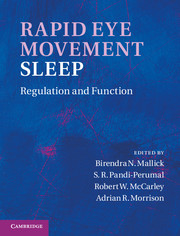Book contents
- Frontmatter
- Contents
- Contributors
- Preface
- Acknowledgments
- Organization
- Section I Historical context
- 1 The sleep–dream state: historic and philosophic perspectives
- 2 REM sleep and dreaming
- 3 REM sleep and dream sleep: are they identical?
- 4 The discovery of REM sleep: the death knell of the passive theory of sleep
- 5 REM sleep and dreaming: the nature of the relationship
- Section II General biology
- Section III Neuronal regulation
- Section IV Neuroanatomy and neurochemistry
- Section V Functional significance
- Section VI Disturbance in the REM sleep-generating mechanism
- Index
- Plate section
- References
5 - REM sleep and dreaming: the nature of the relationship
from Section I - Historical context
Published online by Cambridge University Press: 07 September 2011
- Frontmatter
- Contents
- Contributors
- Preface
- Acknowledgments
- Organization
- Section I Historical context
- 1 The sleep–dream state: historic and philosophic perspectives
- 2 REM sleep and dreaming
- 3 REM sleep and dream sleep: are they identical?
- 4 The discovery of REM sleep: the death knell of the passive theory of sleep
- 5 REM sleep and dreaming: the nature of the relationship
- Section II General biology
- Section III Neuronal regulation
- Section IV Neuroanatomy and neurochemistry
- Section V Functional significance
- Section VI Disturbance in the REM sleep-generating mechanism
- Index
- Plate section
- References
Summary
Summary
The need to study dreaming is the promise that it will unlock the mystery of psychosis and perhaps contribute to resolving the mind–body problem. A number of questions arise in the study of dreams. Can dreams be reliably measured? Do dreams reflect differences where we know psychological differences exist? Do dreams change when there is a change in the state of the dreamer? Do dreams change across the night and across the REM period? Are the dreams of individuals different from one another? And are dreams of an individual different from night to night? Are dreams related to the waking life of the dreamer? Are dreams random or orderly? These are the questions this chapter undertakes to address.
- Type
- Chapter
- Information
- Rapid Eye Movement SleepRegulation and Function, pp. 40 - 48Publisher: Cambridge University PressPrint publication year: 2011



